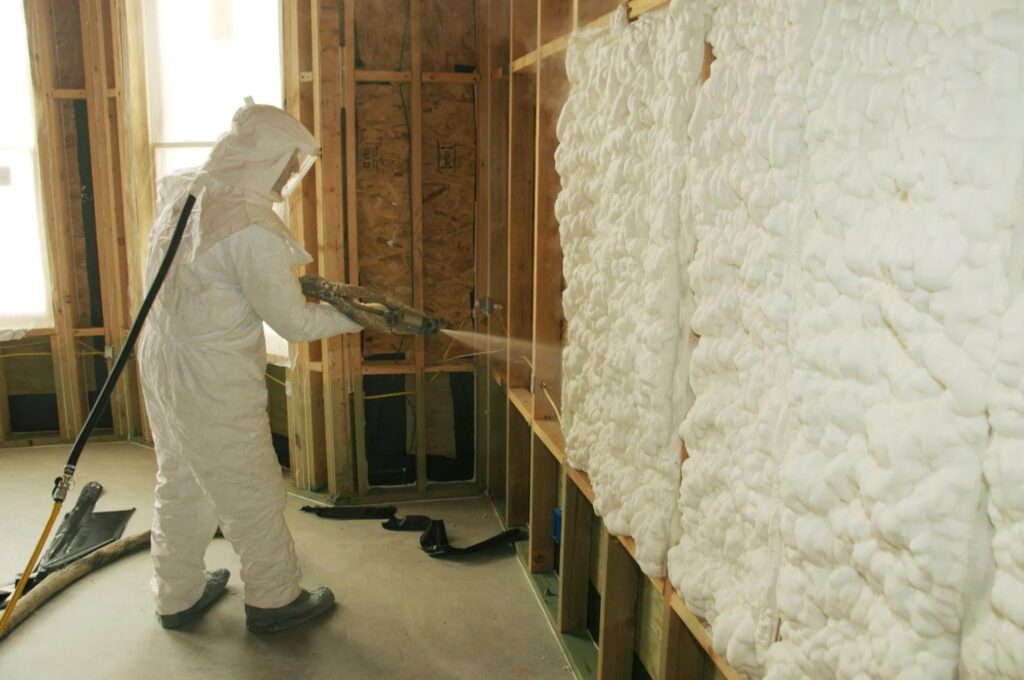Spray foam insulation represents a cutting-edge solution in the realm of home insulation, offering unparalleled efficiency and versatility. Composed of a mixture of chemicals that react to create foam upon application, spray foam insulation provides a seamless and effective barrier against heat transfer, air infiltration, and moisture intrusion to get Attic insulation radiant barrier installation service.
Definition and Composition
Spray foam insulation is formulated from a combination of polyurethane or polyisocyanurate foam, along with other additives and blowing agents. When sprayed onto surfaces, these components react and expand rapidly, forming a dense, insulating layer that adheres to the substrate. The resulting foam insulation provides superior thermal resistance and air sealing properties compared to traditional insulation materials.
Advantages Over Traditional Insulation
Spray foam insulation offers several advantages over conventional insulation materials such as fiberglass or cellulose. Its expansive nature allows it to fill gaps, cracks, and voids more effectively, creating a seamless barrier against heat loss and air infiltration. Additionally, spray foam insulation boasts higher R-values per inch of thickness, providing greater thermal resistance and energy efficiency.
Applications in Various Settings
Due to its versatility and effectiveness, spray foam insulation finds applications in a wide range of settings, including residential, commercial, and industrial buildings. It can be used in attics, walls, floors, and even crawl spaces to provide comprehensive insulation coverage and improve indoor comfort and energy efficiency.
Types of Spray Foam Insulation
Spray foam insulation is available in different formulations to suit specific insulation requirements and budget considerations.
Open-Cell Spray Foam
Open-cell spray foam insulation is characterized by its porous structure, which allows for the diffusion of moisture and air. While offering excellent thermal insulation properties, open-cell foam is more flexible and lightweight compared to closed-cell foam, making it suitable for certain applications where cost-effectiveness and ease of installation are paramount.
Closed-Cell Spray Foam
Closed-cell spray foam insulation features a denser, more compact cellular structure, providing superior thermal insulation and structural integrity. Due to its higher density and moisture resistance, closed-cell foam is often used in areas prone to moisture exposure, such as basements, crawl spaces, and exterior walls. Although typically more expensive than open-cell foam, closed-cell insulation offers enhanced durability and insulation performance.
Hybrid Spray Foam
Hybrid spray foam insulation combines the benefits of both open-cell and closed-cell formulations, offering a versatile solution that balances thermal performance, moisture resistance, and cost-effectiveness. By incorporating a blend of open-cell and closed-cell foam, hybrid insulation can be tailored to meet specific insulation requirements while optimizing installation efficiency and affordability.
Preparation and Application Process
Proper preparation and application are crucial for ensuring the effectiveness and longevity of spray foam insulation installations.
Surface Preparation
Before applying spray foam insulation, the surface must be clean, dry, and free of debris to ensure proper adhesion and insulation performance. Any gaps, cracks, or voids should be sealed, and moisture or mold issues addressed to prevent future damage or deterioration.
Spraying the Foam
The application of spray foam insulation involves the use of specialized equipment, such as spray guns and hoses, to dispense the foam mixture onto the designated surfaces. Installers must apply the foam evenly and in layers to achieve the desired thickness and insulation coverage, taking care to avoid oversaturation or gaps that could compromise performance.
Expansion and Curing
Upon application, spray foam insulation rapidly expands to fill the cavity or space, conforming to the contours of the substrate and creating a seamless insulation barrier. As the foam expands and cures, it forms a durable and airtight seal that effectively blocks heat transfer, air infiltration, and moisture intrusion, ensuring long-lasting insulation performance.
Benefits of Spray Foam Insulation
Spray foam insulation offers a multitude of benefits that contribute to improved energy efficiency, indoor comfort, and structural integrity.
Superior Thermal Performance
One of the primary advantages of spray foam insulation is its superior thermal resistance, which helps to maintain consistent indoor temperatures and reduce heating and cooling costs. By creating an airtight barrier against heat transfer, spray foam insulation minimizes energy loss and improves overall HVAC system efficiency.
Air Sealing Properties
In addition to thermal insulation, spray foam insulation provides excellent air sealing properties, effectively sealing gaps, cracks, and voids to prevent air leakage and drafts. This not only enhances indoor comfort by reducing temperature fluctuations but also improves indoor air quality by preventing the ingress of outdoor pollutants and allergens.
Moisture Resistance
Spray foam insulation’s closed-cell structure offers inherent moisture resistance, making it particularly well-suited for applications in damp or humid environments. By creating a barrier against moisture intrusion, spray foam insulation helps to prevent mold growth, wood rot, and structural damage, thereby preserving the integrity and longevity of the building envelope.
Considerations and Maintenance
While spray foam insulation offers numerous benefits, homeowners should consider various factors and maintenance requirements before making an investment.
Cost Considerations
The upfront cost of spray foam insulation may be higher than traditional insulation materials, such as fiberglass or cellulose. However, its superior performance and energy-saving potential can result in long-term cost savings and a higher return on investment over time. Homeowners should weigh the initial investment against the expected energy savings and other benefits to determine the most cost-effective insulation solution for their needs.
Maintenance Requirements
Spray foam insulation typically requires minimal maintenance once installed. However, periodic inspection and upkeep are recommended to ensure optimal performance and longevity. This may include checking for signs of damage or deterioration, such as cracks, gaps, or discoloration, and addressing any issues promptly to prevent further damage or energy loss.
Longevity and Durability
With proper installation and maintenance, spray foam insulation can provide long-lasting insulation performance and energy savings for many years. Its durable and airtight seal helps to protect against moisture, mold, and pests, reducing the likelihood of premature degradation or replacement. By investing in quality materials and professional installation, homeowners can enjoy the benefits of spray foam insulation for the lifetime of their home.
In conclusion, spray foam insulation offers a revolutionary solution for enhancing energy efficiency, indoor comfort, and structural integrity in residential and commercial buildings. By understanding the different types, installation process, benefits, and maintenance requirements associated with spray foam insulation, homeowners can make informed decisions to optimize their indoor environment and reduce their energy consumption for years to come.



